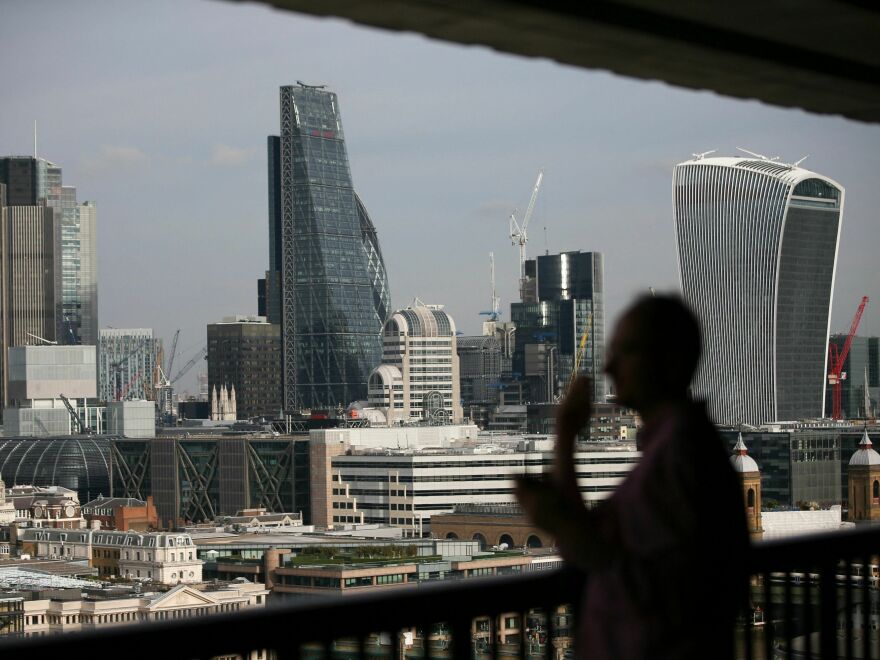Updated February 3, 2023 at 11:09 AM ET
For the last six years, tourists at London's Tate Modern who wandered up to the 10th story could catch a glimpse of one of the gallery's more unusual attractions: the luxury apartments across the way.
Now that unofficial exhibit may be soon closing.
After a years-long legal battle, Britain's Supreme Court ruled on Wednesday that the gallery had violated privacy and nuisance laws. The case has been sent back to a lower court to determine the appropriate remedy, which may include both an injunction and damages in favor of the apartment residents.
Lord George Leggatt, who penned the 3-2 majority opinion, wrote that if the parties couldn't agree themselves on a solution, further hearings may be necessary.
Tate Modern's viewing terrace has served as a popular selfie spot since it opened as part of the Blavatnik Building in 2016. Guests who venture to the top of the tower can take in panoramic views of St. Paul's Cathedral, the Leadenhall Building and the Houses of Parliament.
And then there's the Neo Bankside apartment building, which is roughly 110 feet away. Its sleek architectural design — floor-to-ceiling glass windows and breezy open-plan living areas — maximize natural light while minimizing privacy.

A small sign on the Tate terrace wall gently reminds guests to respect the neighbors, but that hasn't stopped some of the 5.5 million people who attend the free gallery each year from peeking into the quotidian routines of the well-to-do. (A three-bedroom unit is currently listed for sale at over $3 million.)
Five Neo Bankside residents sued Tate Modern in 2017 for what their lawyers described as the "near constant surveillance" state and "unusually intense visual scrutiny." The owners sought an injunction "that would require the gallery either to restrict access to parts of the terrace adjacent to their homes or to erect a screen."
One of the residents once counted 84 people photographing the building over a 90-minute period, according to New York Times coverage of the first round of hearings. He later discovering a photo of himself posted to an Instagram account with 1,027 followers.
The gallery, in its initial response, pointed out that the construction plans for the terrace were publicly available when the apartments went on sale in 2012. A former Tate Modern director and an appellate court judge both suggested the apartment owners could easily fix the issue by hanging curtains.
The apartment owners, in turn, offered to pay for a screen to block off the terrace, which Tate Modern declined. In one attempt to restrict peeping, the gallery decreased the platform's open hours.
In Wednesday's ruling, Leggatt wrote that the onus for fixing the issue lay squarely on the gallery. Contrary to what two lower courts had ruled, the Supreme Court found that the Tate was using its property in an abnormal way by inviting hundreds of thousands of people onto the terrace each year.
Leggatt wrote that the residents, on the other hand, are "doing no more than occupying and using their flats in an ordinary way and in accordance with the ordinary habits of a reasonable person."
"It is no answer for someone who interferes with that use by making an exceptional use of their own land to say that the claimants could protect themselves in their own homes by taking remedial measures," he added.
The court's decision, which could set a precedent for Britain's public spaces, is already drawing criticism for its deference to the comfort of the wealthy few over the enjoyment of the masses.
"With this ruling, the view of just five wealthy flat owners trumps the enjoyment of that very same view by millions of other people a year," wrote a columnist for The Guardian. "The insistence of a few to live without curtains quashes the use of one of the capital's most thrilling public spaces."
A statement from the law firm representing the residents described the ruling as "a robust re-assertion of the protection afforded by common law to privacy in the home."
"Our clients now look forward to working with the Tate as valued neighbours to find a practical solution which protects all of their interests," said Natasha Rees, the residents' lead lawyer.
In a statement shared with NPR, the Tate Modern thanked the court for its "careful consideration of this matter" but said it couldn't comment further given that the case was ongoing.
Copyright 2023 NPR. To see more, visit https://www.npr.org.



